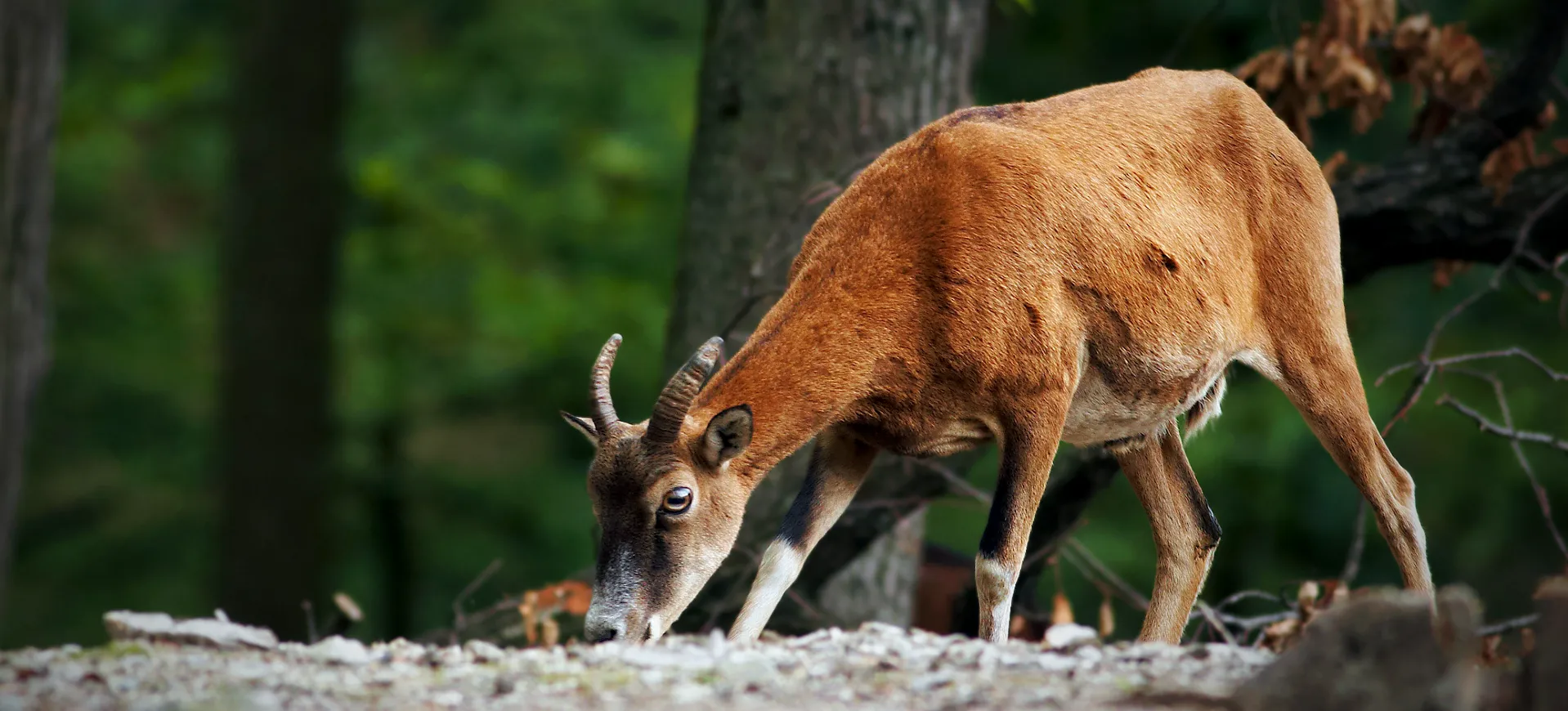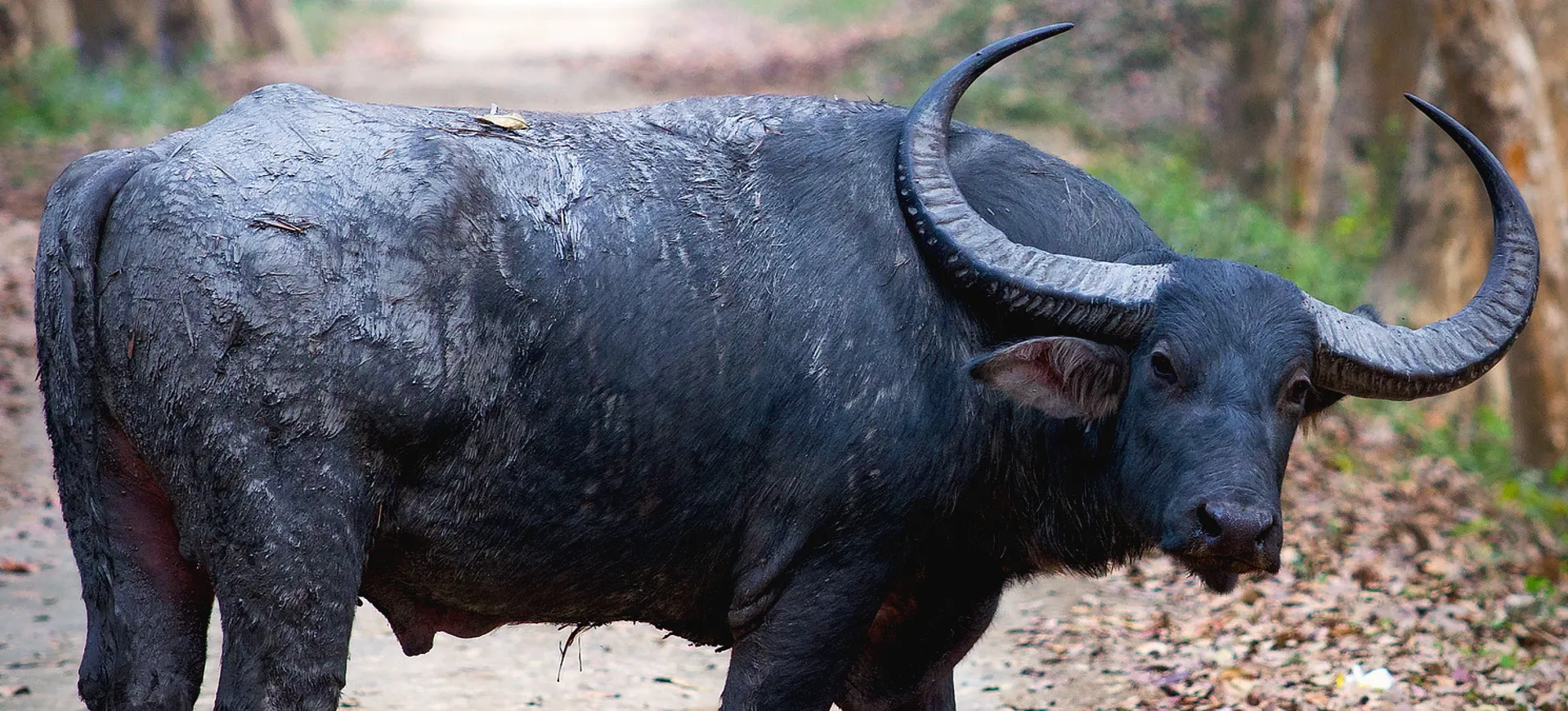Overview
The Mishmi Takin (Budorcas taxicolor taxicolor) is a subspecies of the Takin, native to the northeastern part of India, northern Myanmar, and the Yunnan Province of China. This large, robust animal is well adapted to the cold, moist environment of the Eastern Himalayas, thriving in dense bamboo and rhododendron forests at elevations of 2,000 to 4,500 meters. Characterized by its thick, woolly coat, which ranges from golden-yellow to dark brown, the Mishmi Takin has distinctive facial markings with a white frost-like appearance, contributing to its unique look. They possess a strong, stocky build with sturdy legs and cloven hooves well-suited for navigating their mountainous habitat’s steep, rugged terrain.
Mishmi Takins are social animals, forming herds that provide protection from predators and facilitate finding food and mates. Their diet consists mainly of leaves, bamboo, and grasses, with an ability to digest a wide range of vegetation thanks to their complex four-chambered stomach. They play a critical role in their ecosystem by acting as seed dispersers and maintaining the health of their forest habitats. Despite their significance, the Mishmi Takin faces threats from habitat loss, hunting, and competition with domestic livestock, highlighting the need for continued conservation efforts.
The adaptability of the Mishmi Takin to its harsh environment showcases the remarkable resilience of this species. Conservation initiatives focus on habitat protection, anti-poaching measures, and community engagement to ensure the survival of the Mishmi Takin. Their presence in the Eastern Himalayas is a testament to the biodiversity of this region and the importance of protecting such unique habitats. The Mishmi Takin is a flagship species for conservation in this area, symbolizing the rich natural heritage that requires our attention and action.
Taxonomy
Kingdom
Phylum
Class
Order
Family
Genus
Species
Sub Species
Type
Physical Description:
The Mishmi Takin is notable for its large size, with adults reaching up to 87 inches (220 cm) in length and weighing 550-770 lbs (250-350 kg). Its dense fur is well adapted to its habitat’s cold, damp conditions, with the unique feature of a greasy coating that provides water resistance. The males are larger than the females and possess large, curved horns extending up to 64 centimeters, used for defense and mating contests. The white facial markings against their darker fur aid in camouflage and serve as a distinguishing feature among individuals within herds.
Their robust limbs and cloven hooves are designed to climb and navigate their challenging mountainous environment. The Mishmi Takin’s thick neck and powerful shoulders enable it to push through dense underbrush and snow, searching for food during the harsh winter months. Seasonal changes in their coat color, from lighter summer shades to darker winter hues, provide additional camouflage against predators and the elements. These physical attributes underscore the Mishmi Takin’s adaptation to its environment and role as a formidable species in the Eastern Himalayas.

Lifespan: Wild: ~20 years || Captivity: ~20 years

Weight: Male & Female: 550-770 lbs (250-350 kg)

Length: Male & Female: 67-87 inches (170-220 cm)

Height: Male & Female: 39-51 inches (100-130 cm) at the shoulder
Characteristic:
Native Habitat:
The Mishmi Takin inhabits the dense bamboo and rhododendron forests of the Eastern Himalayas, specifically in the northeastern part of India, northern Myanmar, and the Yunnan Province of China. They thrive at elevations ranging from 2,000 to 4,500 meters, where the rugged terrain and dense vegetation provide shelter and abundant food sources. The climate in their habitat is characterized by cold temperatures, high humidity, and significant rainfall, creating a challenging environment that the Mishmi Takin is well adapted to navigate. The preservation of these habitats is critical for the survival of the Mishmi Takin, as they rely on the availability of natural resources and protection from human encroachment.
Conservation efforts in their native habitat include establishing protected areas and wildlife reserves and safeguarding the Mishmi Takin and the region’s biodiversity. Habitat connectivity is essential for their seasonal migrations and access to diverse feeding grounds. Their remote and often inaccessible habitat provides some protection, but increasing threats from deforestation, habitat fragmentation, and climate change underscore the need for ongoing conservation action. The Mishmi Takin’s dependence on these specific environmental conditions highlights the importance of comprehensive habitat protection strategies.
Climate Zones:
Biomes:
Biogeographical Realms:
Continents:
Countries:
Diet:
Diet & Feeding Habits:
The Mishmi Takin’s diet is predominantly herbivorous, consisting of various mountain vegetation, including leaves, shoots, grasses, and bamboo. Their specialized lips and tongue enable them to select the most nutritious parts of plants, while their complex digestive system efficiently processes the fibrous plant material. In the winter, they may migrate to lower altitudes to access food, showcasing their adaptability to seasonal changes in their environment. Their feeding habits play a vital role in seed dispersal, contributing to the regeneration and health of their forest habitats.
Mishmi Takins visit salt licks and mineral springs, which are essential for supplementing their diet with minerals not readily available in plants. These excursions often lead to the formation of temporary aggregations, allowing for social interactions and the strengthening of herd bonds. The ability to forage in dense forests and rugged terrain highlights the Mishmi Takin’s role as a keystone species in maintaining the ecological balance of their habitat. Protecting their foraging areas from degradation and competition with livestock is crucial for conserving this species.
Mating Behavior:
Mating Description:
The mating season for the Mishmi Takin occurs in the late spring and early summer when males compete fiercely for access to females. These battles involve charging and clashing their horns, with the strongest males winning the right to mate. After a successful mating, females undergo a gestation period of about seven to eight months, giving birth to a single calf in late winter or early spring. The mother then isolates herself from her newborn, providing milk and protection until it is strong enough to join the herd.
The care provided by the mother is crucial for the calf’s survival, which is vulnerable to predators and harsh environmental conditions. Calves are precocial and can stand and follow their mothers within a day of birth, essential for mobility in the rugged terrain. The bond between the mother and calf is strong, with the calf relying on its mother for nourishment and learning essential life skills. Conservation efforts that protect critical breeding areas and calving sites are vital for the reproductive success and population growth of the Mishmi Takin.
Reproduction Season:
Birth Type:
Pregnancy Duration:
Female Name:
Male Name:
Baby Name:
Social Structure Description:
Mishmi Takins are social animals that form herds of various sizes, from small family groups to larger aggregations, especially in winter when food is scarce. Within these herds, a hierarchy influences access to resources and mating opportunities. Herd composition can change seasonally, with males forming bachelor groups outside the breeding season. The social bonds within herds play a crucial role in their survival, offering protection against predators and facilitating the sharing of knowledge, such as the locations of food and salt licks.
The formation of herds provides safety in numbers, an important survival strategy in their predator-rich environment. Calves benefit from the herd’s protection and the opportunity to learn social and foraging behaviors from older members. Seasonal migrations and the formation of nursery groups during the calving season are key aspects of their social life. Understanding and preserving the social structure of the Mishmi Takin is essential for their conservation, impacting their reproduction, foraging efficiency, and overall well-being.
Groups:
Conservation Status:
Population Trend:
The Mishmi Takin is classified as Vulnerable by the IUCN Red List, with habitat loss, fragmentation, and poaching identified as the primary threats to their survival. Efforts to combat these threats include establishing protected areas, stricter law enforcement to deter poaching and habitat restoration projects. Despite these initiatives, the Mishmi Takin’s population is believed to be declining, with isolated groups facing increased risks from inbreeding and reduced genetic diversity. Conservation strategies focus on connecting fragmented habitats, increasing public awareness, and involving local communities in conservation efforts.
Protecting the Mishmi Takin is integral to preserving the biodiversity of China’s and India’s mountainous regions. Research into their ecology, behavior, and genetics is crucial for informing conservation actions and ensuring the species’ long-term survival. International cooperation and funding are also necessary to support these conservation efforts. The Mishmi Takin is an emblem of the conservation challenges and opportunities in the Eastern Himalayas, symbolizing the need for concerted action to protect these unique ecosystems.
Population Threats:
The Mishmi Takin faces several significant threats, including deforestation and habitat degradation from agricultural expansion, infrastructure development, and logging. Illegal hunting for their pelts, horns, and meat continues despite legal protections, further reducing their numbers. Competition with domestic livestock for grazing areas reduces available food resources and increases the risk of disease transmission to wild populations. Climate change poses an additional threat, potentially altering the habitats and food sources the Mishmi Takin relies on for survival.
Efforts to combat these threats include implementing sustainable land-use practices, enhancing surveillance and protection in key habitats, and promoting alternative livelihoods for local communities to reduce dependence on taking habitats. Disease management and biosecurity measures are crucial for minimizing the impact of livestock on wild populations. The challenges facing the Mishmi Takin underscore the importance of a holistic approach to conservation that addresses both the immediate threats to their survival and the long-term health of their ecosystems.
Conservation Efforts:
Conservation initiatives for the Mishmi Takin involve habitat protection through creating and managing protected areas and national parks. Anti-poaching measures, including patrols and law enforcement, are critical for preventing illegal hunting. Community engagement programs aim to raise awareness about the Mishmi Takin’s plight and involve local populations in conservation efforts, promoting coexistence and sustainable resource use. Habitat restoration and connectivity projects help to ensure the Mishmi Takin has access to ample territory for feeding, breeding, and migration.
Research and monitoring programs provide valuable insights into Mishmi Takin’s behavior, population dynamics, and habitat use, guiding effective conservation strategies. International collaboration enhances the efforts to protect the Mishmi Takin, sharing knowledge, resources, and best practices across borders. Conservation education and advocacy raise public support for conservation and protecting their habitats. Through these efforts, there is hope for the recovery and sustainable management of Mishmi Takin populations and their unique Himalayan ecosystems.
Additional Resources:
Fun Facts
- Mishmi Takins have a special gland that secretes an oily substance, giving their coat a distinctive wet, shiny appearance that helps repel water.
- They are excellent climbers and can easily navigate steep, rocky slopes, showcasing their adaptability to the mountainous terrain.
- Mishmi Takins can alter their diet based on seasonal availability, showing remarkable dietary flexibility.
- Their thick, woolly coat provides warmth and camouflage in the snowy and rocky landscapes they inhabit.
- The vocalizations of Mishmi Takins, including grunts and snorts, are used for communication within the herd, especially between mothers and calves.
- They are named after the Mishmi hills, where they are found, highlighting their cultural and geographical significance to the region.
- Mishmi Takins have a unique way of sleeping, often tucking their legs under their body and resting their head on their back.
- Despite their heavy build, Mishmi Takins are capable of swift runs when threatened by predators or during social displays.
- Their sense of smell is vital for locating food under the snow and detecting predators or other herds.
- Conservation efforts for the Mishmi Takin also benefit other endangered species sharing their habitat, underscoring their role as an umbrella species in biodiversity conservation initiatives.

















































































